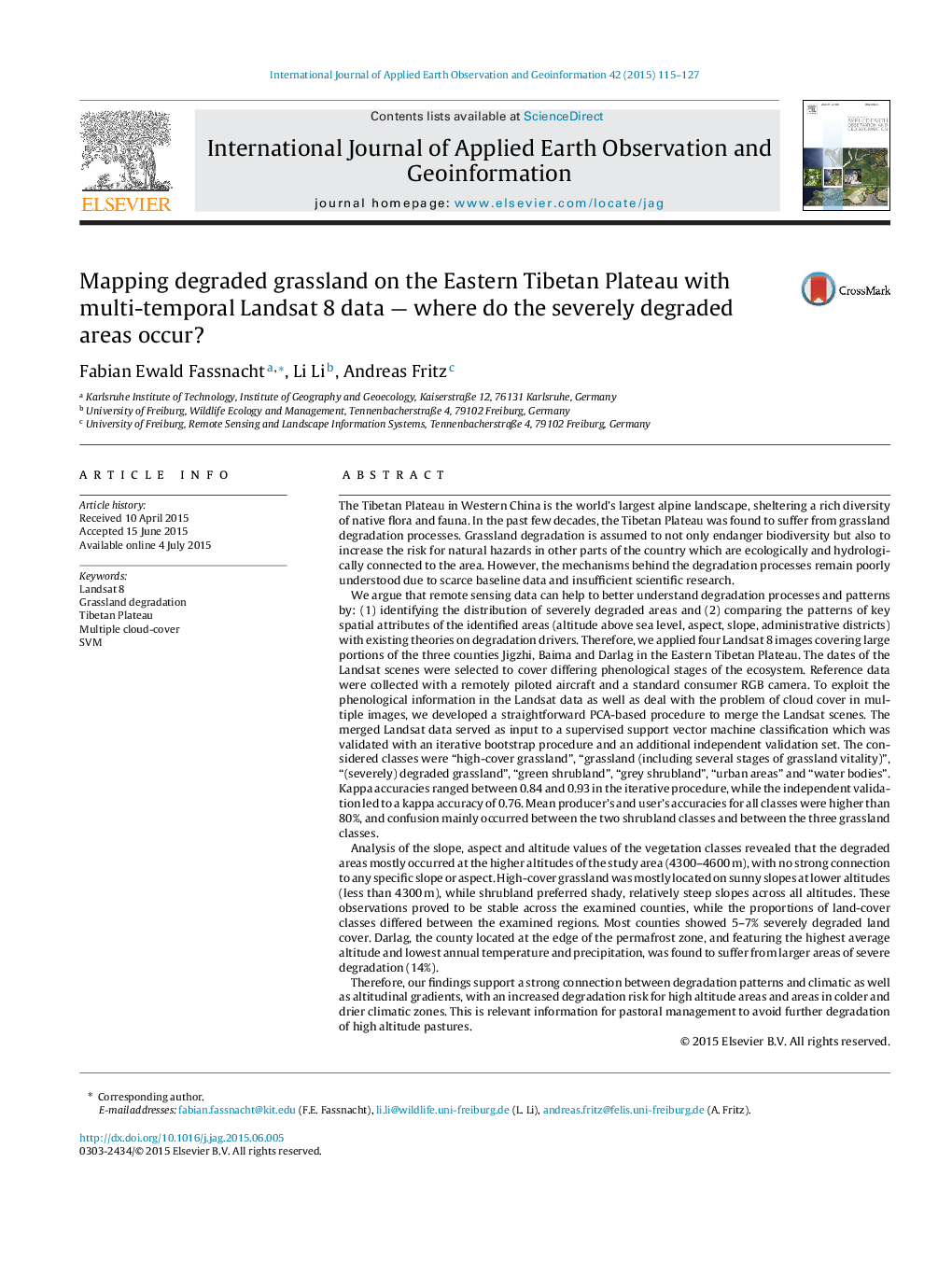| Article ID | Journal | Published Year | Pages | File Type |
|---|---|---|---|---|
| 4464702 | International Journal of Applied Earth Observation and Geoinformation | 2015 | 13 Pages |
•Multi-temporal LS8 data was used to map degradation on the Tibetan plateau.•Reference data was collected from a remotely piloted aircraft.•A procedure to address multiple cloud-cover in the 4 LS8 scenes was developed.•Degraded grassland was mainly located at high altitudes of 4200–4600 m.•Degradation is connected to two gradients, one altitudinal and one climatical.
The Tibetan Plateau in Western China is the world’s largest alpine landscape, sheltering a rich diversity of native flora and fauna. In the past few decades, the Tibetan Plateau was found to suffer from grassland degradation processes. Grassland degradation is assumed to not only endanger biodiversity but also to increase the risk for natural hazards in other parts of the country which are ecologically and hydrologically connected to the area. However, the mechanisms behind the degradation processes remain poorly understood due to scarce baseline data and insufficient scientific research.We argue that remote sensing data can help to better understand degradation processes and patterns by: (1) identifying the distribution of severely degraded areas and (2) comparing the patterns of key spatial attributes of the identified areas (altitude above sea level, aspect, slope, administrative districts) with existing theories on degradation drivers. Therefore, we applied four Landsat 8 images covering large portions of the three counties Jigzhi, Baima and Darlag in the Eastern Tibetan Plateau. The dates of the Landsat scenes were selected to cover differing phenological stages of the ecosystem. Reference data were collected with a remotely piloted aircraft and a standard consumer RGB camera. To exploit the phenological information in the Landsat data as well as deal with the problem of cloud cover in multiple images, we developed a straightforward PCA-based procedure to merge the Landsat scenes. The merged Landsat data served as input to a supervised support vector machine classification which was validated with an iterative bootstrap procedure and an additional independent validation set. The considered classes were “high-cover grassland”, “grassland (including several stages of grassland vitality)”, “(severely) degraded grassland”, “green shrubland”, “grey shrubland”, “urban areas” and “water bodies”. Kappa accuracies ranged between 0.84 and 0.93 in the iterative procedure, while the independent validation led to a kappa accuracy of 0.76. Mean producer’s and user’s accuracies for all classes were higher than 80%, and confusion mainly occurred between the two shrubland classes and between the three grassland classes.Analysis of the slope, aspect and altitude values of the vegetation classes revealed that the degraded areas mostly occurred at the higher altitudes of the study area (4300–4600 m), with no strong connection to any specific slope or aspect. High-cover grassland was mostly located on sunny slopes at lower altitudes (less than 4300 m), while shrubland preferred shady, relatively steep slopes across all altitudes. These observations proved to be stable across the examined counties, while the proportions of land-cover classes differed between the examined regions. Most counties showed 5–7% severely degraded land cover. Darlag, the county located at the edge of the permafrost zone, and featuring the highest average altitude and lowest annual temperature and precipitation, was found to suffer from larger areas of severe degradation (14%).Therefore, our findings support a strong connection between degradation patterns and climatic as well as altitudinal gradients, with an increased degradation risk for high altitude areas and areas in colder and drier climatic zones. This is relevant information for pastoral management to avoid further degradation of high altitude pastures.
